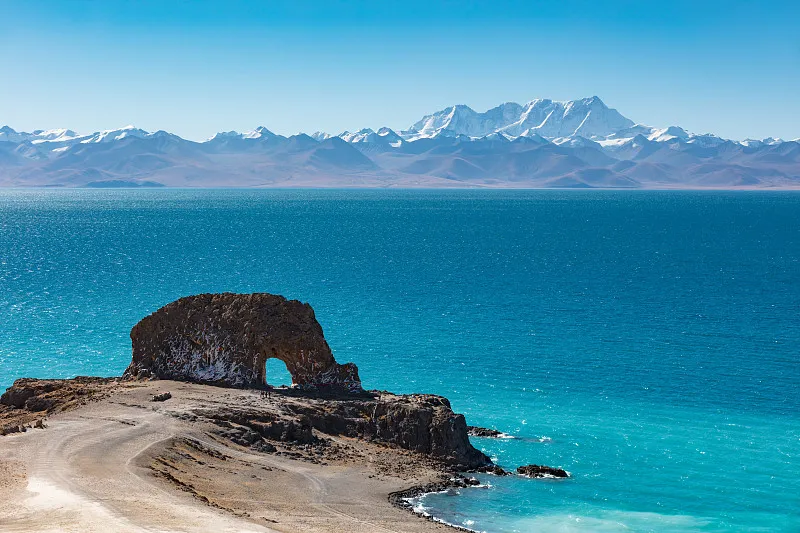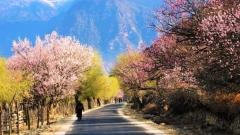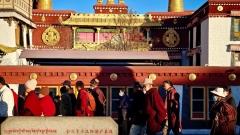High above the clouds, on a vast plateau surrounded by snow-covered peaks and deep blue lakes, lies Tibet – a land that feels closer to heaven than to earth. From the mighty Himalayas to the tranquil lakes, from sacred monasteries perched on mountain slopes to the mysterious deserts of the west, Tibet offers a journey that awakens both the eyes and the spirit. Travelers who come to Tibet are not only drawn by its physical beauty but also by the sense of peace and mystery that lingers in its air. Here, nature and spirituality merge seamlessly, offering visitors an unforgettable experience that feels timeless and pure.
The Majestic Mountains of Tibet
The Himalayas: The Roof Touching the Sky
When people think of Tibet, the image that most often comes to mind is that of the Himalayas, the most famous mountain range in the world. Stretching over 2,400 kilometers, the Himalayas form the southern boundary of Tibet and include Mount Everest (8,848 meters) — the world’s highest peak. Known locally as Qomolangma, Everest’s snow-clad summit glows gold under the morning sun, creating one of the most awe-inspiring sights on Earth.
The Himalayas are not only a geological wonder but also a sacred presence in the hearts of Tibetans. For generations, these mountains have been seen as the home of gods and spiritual beings. Many travelers visit the Everest Base Camp in Tibet to witness this natural wonder up close, standing beneath the towering peaks that pierce the sky.
The Gangdise Range and Sacred Mt. Kailash
While the Himalayas are globally renowned, the Gangdise Mountains in western Tibet are equally remarkable. Their main peak, Mount Kailash (6,721 meters), is considered one of the holiest mountains in the world. It holds deep spiritual meaning in Hinduism, Buddhism, Jainism, and Bon, the indigenous religion of Tibet.
For pilgrims, circumambulating Mount Kailash — a journey of about 52 kilometers — is an act of great devotion believed to cleanse one’s sins and bring spiritual merit. Even for non-religious travelers, standing before this perfectly symmetrical peak is a profoundly humbling experience. The area surrounding Mt. Kailash, including the Manasarovar and Rakshastal Lakes, forms one of the most mystical landscapes in all of Tibet.
The Nyenchen Tanglha and Tanggula Ranges
Another significant mountain range in Tibet is the Nyenchen Tanglha Range, with its highest peak reaching 7,162 meters. The mountain’s jagged ridges, often covered by mist and snow, dominate the landscape north of Lhasa. Locals believe this range is inhabited by powerful mountain spirits, and many sacred lakes lie at its foot — including the famous Namtso Lake.
To the north lies the Tanggula Mountains, known as the source of the Yangtze River, Asia’s longest river. These ranges, blanketed in ice and snow year-round, showcase the untamed wilderness of northern Tibet — remote, cold, and breathtakingly beautiful.

Mount Kailash
Lakes of Light: The Shimmering Jewels of Tibet
The Heavenly Namtso Lake
Few landscapes on Earth can match the serene beauty of Namtso Lake, one of Tibet’s most stunning natural wonders. Often called the “Heavenly Lake,” Namtso sits at an altitude of 4,718 meters, making it one of the highest saltwater lakes in the world. Its waters shift in color throughout the day — from sapphire blue in the morning to turquoise and deep indigo by dusk. Encircled by snowy peaks and vast grasslands, Namtso creates a view so pure that it feels like a glimpse of paradise.
At night, the sky above Namtso transforms into a dazzling galaxy of stars, making it one of the best stargazing locations in the world.
Yamdrok Lake: The Turquoise Treasure
Just a few hours’ drive from Lhasa lies Yamdrok Lake, another of Tibet’s three sacred lakes. Winding like a turquoise ribbon through the mountains, Yamdrok is revered by Tibetans as the “life-spirit lake.” Its waters are believed to bless the land and ensure fertility and happiness.
Travelers who climb the Kamba La Pass (4,749 meters) are rewarded with a panoramic view of Yamdrok’s shimmering expanse — a sight so stunning that it has inspired countless poets and painters.
Lake Manasarovar: Sacred Waters Beneath the Holy Mountain
Located near Mount Kailash, Lake Manasarovar is one of the world’s most spiritually significant bodies of water. Pilgrims from across Asia travel here to bathe in its waters or simply to sit quietly along its shores, reflecting on the meaning of life and the universe. The lake’s pristine blue surface mirrors the surrounding mountains, creating a scene of extraordinary tranquility.
In total, Tibet is home to over 1,500 lakes, each with its own story and charm. Many of these lakes change colors throughout the year, their hues shifting with the angle of the sun — a perfect symbol of Tibet’s ever-changing natural palette.

Namtso
Monasteries and Spiritual Landscapes
The Heart of Tibetan Culture
Tibet’s landscape is not only physical but also spiritual. Scattered across its mountains and valleys are more than 6,000 monasteries, each a living center of faith, culture, and history. Visiting them offers a glimpse into the heart of Tibetan Buddhism and the daily lives of monks who devote themselves to prayer and meditation.
Iconic Monasteries to Visit
Among the most famous are the Jokhang Temple in Lhasa, regarded as the spiritual center of Tibet; the Sera Monastery, known for its lively monk debates; the Drepung Monastery, once the largest in the world; and the Ganden Monastery, offering sweeping views over the Lhasa Valley.
These sacred sites are masterpieces of Tibetan architecture — with golden roofs, colorful murals, and spinning prayer wheels that hum softly in the mountain wind. Every visitor, regardless of faith, can feel the sense of serenity that permeates these ancient walls.
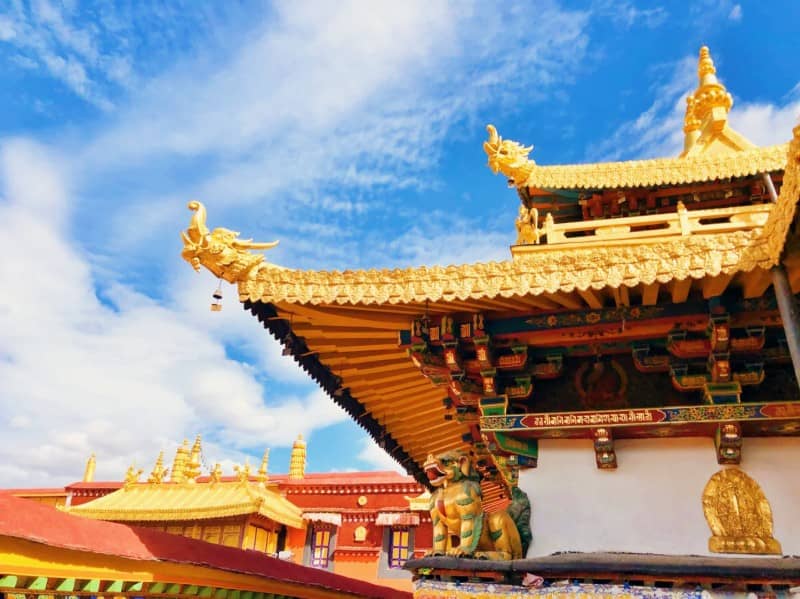
Jokhang Temple
The Western Barren: Desolation and Mystery
The Land of Silence
Western Tibet, though sparsely populated, is home to some of the most fascinating geological and cultural landscapes in the region. Covering an area of more than 300,000 square kilometers, this vast barren land is inhabited by only about 70,000 people — less than one person per square kilometer. Yet within this silence lies profound beauty.
The Zanda Clay Forest, carved by centuries of wind and water erosion, stretches like a labyrinth of natural sculptures. Its pale golden formations glow under the sunlight, creating a surreal landscape that feels almost lunar.
The Ancient Kingdom of Guge
Amid these clay cliffs lie the Ruins of the Guge Kingdom, a forgotten civilization that once flourished more than a thousand years ago. The ruins, along with nearby rock paintings, reveal a culture that blended Tibetan, Indian, and Nepalese influences. Exploring this region feels like stepping back in time, into a world lost to history but preserved by the desert’s silence.

Guge
Lush Forests, Glaciers, and Blossoms
Nyingchi: Tibet’s Hidden Paradise
In contrast to the starkness of western Tibet, the Nyingchi region in the east offers a completely different world — one of lush forests, rushing rivers, and blooming flowers. Often called the “Jiangnan of Tibet” (referring to the fertile southern regions of China), Nyingchi’s lower altitude and mild climate allow for rich vegetation and colorful scenery.
The Yarlung Zangbo Grand Canyon, the deepest canyon on Earth, cuts dramatically through this region. Nearby lies Lulang Forest, a 15-kilometer stretch of fir and pine trees that look almost alpine. During spring, the area bursts into life with the Bomi Peach Blossom Festival, when the valleys turn pink with blossoms, creating one of the most romantic scenes in all of Tibet.
The Glaciers of Bomi
Bomi is also known as the “Town of Glaciers,” with more than 2,000 glaciers scattered throughout the region. The Midui Glacier, in particular, is famed for its majestic beauty — where snow-capped peaks, dense forests, and mirror-like lakes coexist in harmony.
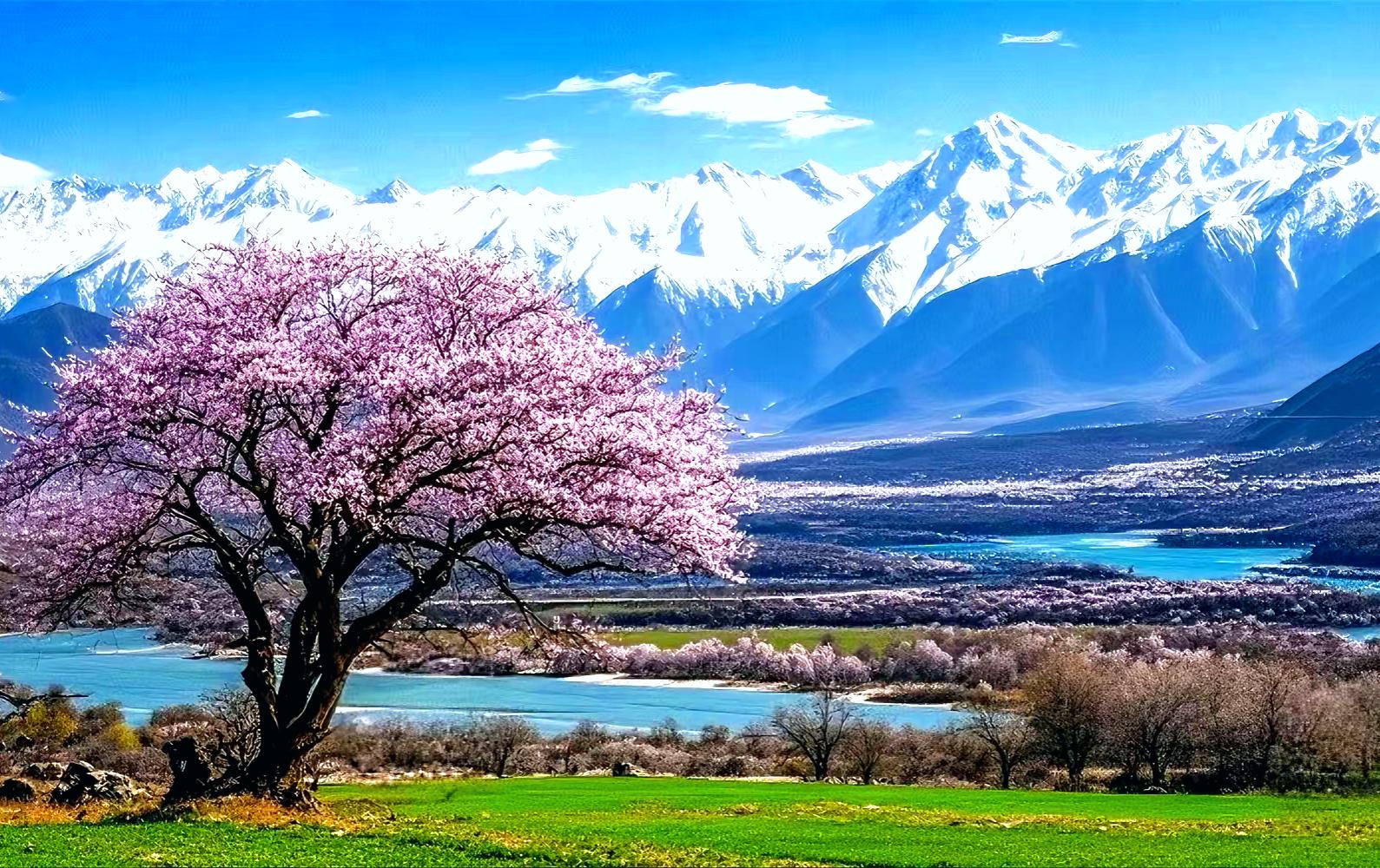
Nyingchi Peach Blossom
A Journey Beyond the Horizon – Travel with China Dragon Travel
Tibet’s landscape is more than a destination — it is a journey of the soul. From the towering Himalayas to the tranquil lakes, from the sacred monasteries to the whispering forests of Nyingchi, every corner of Tibet tells a story of nature’s grandeur and spiritual devotion. For travelers seeking not just beauty, but meaning — Tibet offers both. It invites you to slow down, breathe deeply, and reconnect with the essence of the world.
To explore Tibet’s landscapes safely and deeply, China Dragon Travel offers expertly curated Tibet tours that combine natural wonders with authentic cultural encounters.
👉 Plan your once-in-a-lifetime Tibet adventure with China Dragon Travel – where every landscape becomes a living story.





